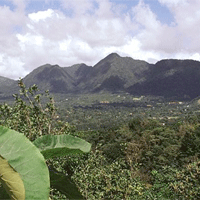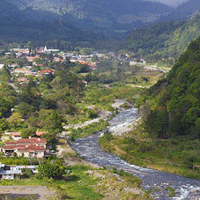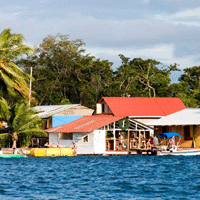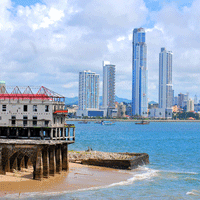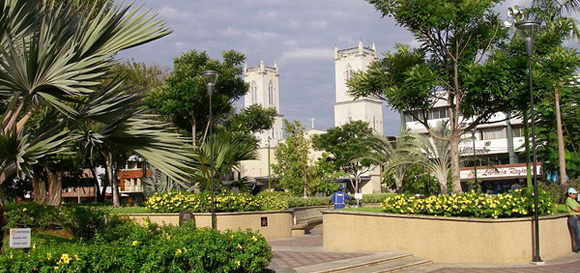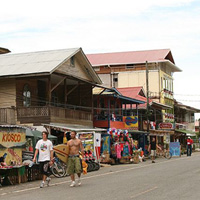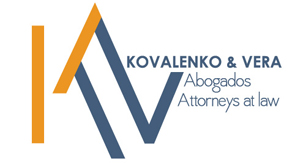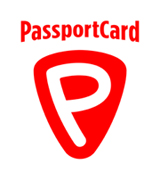Panama
Coastal BeachesPanama is a country located at the junction of Central and South America, known for its famous Panama Canal, which serves as a conduit for maritime trade connecting the Atlantic and Pacific Oceans. The country's landscape is characterized by a diverse range of features including tropical rainforests, mountains, and extensive coastlines with beautiful beaches. Panama City, the capital, is a modern, cosmopolitan city that contrasts with the indigenous cultures found in more remote areas. The country's rich biodiversity is evident in places like the Darién Gap and the many national parks and wildlife sanctuaries. Panama's economy is service-based, heavily centered on banking, commerce, and tourism. Despite its small size, Panama has a vibrant cultural scene, with influences from Afro-Caribbean, indigenous, and Latin American heritages. Festivals, music, and dance play a significant role in Panamanian social life. The country's climate is tropical with a wet and dry season, and due to its geographical position, it is largely hurricane-free. Panama also serves as a gateway to expatriates and retirees, particularly in areas like Boquete and Bocas del Toro, where communities have developed around the influx of international residents. The Panama Canal's expansion, completed in 2016, has further boosted the country's strategic importance in global trade. Overall, Panama offers a unique blend of modern amenities and natural beauty, making it an attractive destination for tourists and expatriates alike.
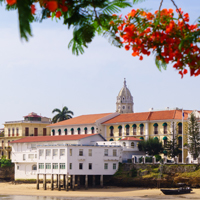 Kovalenko & Vera Attorneys at Law in Panama
Kovalenko & Vera Attorneys at Law in PanamaConnect
Kovalenko & Vera is a Panamanian law firm that specializes in immigration law, corporate law, real estate law, banking, contract negotiation, taxes and flag registry. With more than 20 years of professional practice, Kovalenko & Vera builds lasting relationships with our clients to ensure your interests are safeguarded.
Click connect to have our partner contact you via e-mail and/or phone.
 Kovalenko & Vera Attorneys at Law in Panama
Kovalenko & Vera Attorneys at Law in PanamaKovalenko & Vera is a Panamanian law firm that specializes in immigration law, corporate law, real estate law, banking, contract negotiation, taxes and flag registry. With more than 20 years of professional practice, Kovalenko & Vera builds lasting relationships with our clients to ensure your interests are safeguarded.
Connect
Click connect to have our partner contact you via e-mail and/or phone.
Living in Panama
Best Places to Live in Panama
Visa & Residency
Panama is known for its welcoming stance towards expatriates and retirees, offering a variety of options that cater to different needs. The process of obtaining a residency visa in Panama involves several steps and the complexity can vary depending on the type of visa applied for. Two of the most popular visas are the Friendly Nations Visa and the Pensionado Visa. The Friendly Nations Visa is designed for citizens from a list of countries that Panama considers to have friendly relations with. Applicants must demonstrate economic ties to the country, which can typically be done by opening a local bank account with a minimum balance and either buying property in Panama or establishing a business. This visa leads to permanent residency and is a popular route for expats looking to work or start a business in Panama. The Pensionado Visa, on the other hand, is aimed at retirees. To qualify, applicants must prove they receive a lifetime pension of at least $1,000 per month. This visa offers numerous benefits, including discounts on services and entertainment in the country. It is a straightforward option for those looking to retire in Panama. For digital nomads, Panama introduced the Short Stay Visa for Remote Workers, which allows them to live in Panama for up to 9 months, with the possibility of extending for another 9 months. Applicants must provide proof of employment or business ownership outside of Panama, and show that they earn a stable monthly income. The general process for obtaining a residency visa in Panama involves hiring a local attorney to help navigate the legal requirements, preparing and submitting the necessary documentation (such as passport copies, proof of income, and health certificates), and paying the associated fees. After the application is submitted, it may take several months to be processed. Once approved, applicants usually receive a temporary residency card, and eventually, a permanent residency card. The process is considered to be easier and more streamlined than in many other countries, making Panama an attractive destination for expats and retirees.
Healthcare in Panama
Panama's healthcare system is a combination of public and private facilities. The public healthcare system is accessible to all citizens and legal residents, including expats who have obtained permanent residency. It is funded by the government and provides a range of services at a low cost. However, public hospitals and clinics may not offer the same level of comfort or advanced technology as private facilities. Private healthcare in Panama is known for its high quality and modern facilities, with many doctors trained in the US or Europe. It is more expensive than public healthcare but still affordable compared to North American standards. Expats and digital nomads can access public healthcare once they have residency status, but many opt for private health insurance to cover services at private hospitals. The quality of healthcare can vary depending on the region, with urban areas typically offering better services than rural ones.
Cost of Living
Panama's cost of living is considered moderate compared to many Western countries. While costs can be higher in the capital city, especially for housing and entertainment, other areas offer more affordable living expenses.
Weather
Panama has a tropical maritime climate with a hot, humid, and rainy season from May to December and a short dry season from January to April. Temperatures are consistently high throughout the year, averaging around 27°C (81°F). Due to its geographical location, Panama experiences little variation in temperature but significant rainfall, particularly on the Caribbean coast.
Educational System in Panama
The educational system in Panama is structured similarly to many other countries, with a mix of public and private institutions. Education is compulsory for children from ages 6 to 15, which includes primary and secondary schooling. The school year in Panama typically runs from March to December, with a long summer break from mid-December to late February. Primary education, known as educación primaria, consists of six grades and generally starts at age six. After completing primary school, students move on to pre-secondary (7th grade) and secondary education (8th to 11th grade), known as educación pre media and educación media, respectively. Secondary education culminates in a diploma de bachiller, which is necessary for university admission. The quality of education in Panama varies, with private schools often providing a higher standard of education, sometimes following international curriculums like the International Baccalaureate. Public schools are free, but they may lack resources compared to private institutions. For expatriate families, there are international schools that offer education in English and other languages, adhering to different national education systems or international standards.
Universities in Panama
The university system in Panama consists of both public and private institutions, with the University of Panama being the largest and oldest public university in the country. Higher education typically follows a four-year bachelor's degree structure, although some programs, such as engineering or architecture, may take five years to complete. Graduate programs, including master's and doctoral degrees, are also available. The academic year is usually divided into two semesters, with a short break in between and a longer break over the summer months. Admission to universities in Panama generally requires a high school diploma and passing entrance examinations. For foreign students, proficiency in Spanish is often necessary, as most courses are taught in Spanish, although some programs may be available in English. Costs for attending university in Panama can vary widely, with public universities being significantly less expensive than private ones. Foreign students should consider additional costs such as visa fees, health insurance, and living expenses. Financial aid and scholarships may be available, but they are more limited for international students. The quality of higher education in Panama is recognized in Latin America, and universities often have partnerships with institutions abroad, facilitating exchange programs and international research collaborations.
Copyright 1997-2025 Burlingame Interactive, Inc.

